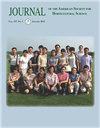Genetic Analysis of the Unique Epicuticular Wax Profile of ‘Odourless Greenleaf’ Onion
IF 1.1
4区 农林科学
Q3 HORTICULTURE
Journal of the American Society for Horticultural Science
Pub Date : 2021-03-01
DOI:10.21273/JASHS05024-20
引用次数: 1
Abstract
The amounts and types of epicuticular waxes on onion (Allium cepa) leaves affect the severity of feeding damage by onion thrips (Thrips tabaci), a serious insect pest of onion. Onion plants with light green leaves are referred to as “glossy” and accumulate less epicuticular wax relative to the blue–green (“waxy”) foliage of wild-type onion. The onion cultivar Odourless Greenleaf (OGL) has visually glossy foliage, shows resistance to thrips feeding damage, and has the unique profile of accumulating waxes with 28 or fewer carbons. Plants of glossy OGL were crossed with the glossy inbred B9885 and waxy inbred lines DH2107, DH066619, and B8667. Hybrid progenies from glossy OGL by waxy plants had waxy foliage, indicating recessiveness of the glossy OGL phenotype relative to the waxy phenotype. Hybrids from the cross of glossy OGL with glossy B9885 were also waxy, revealing different genetic bases for the glossy phenotype in these two onions. Hybrid plants were self-pollinated and segregations in F2 families from OGL × waxy crosses fit the expected 3:1 ratio for the single locus at which the homozygous recessive genotype conditions glossy foliage. Segregations in F2 families from crosses of glossy 9885 × glossy OGL fit the 9:7 ratio, supporting two independently segregating loci, where the recessive genotype at either locus conditions the glossy phenotype. Amounts and types of epicuticular waxes on leaves of F2 progenies from crosses of OGL × waxy B8667 and glossy B9885 × OGL were determined using gas chromatography-mass spectrometry. Single-nucleotide polymorphisms were genotyped and genetic maps were constructed. The visually glossy phenotype from OGL and its unique profile of epicuticular waxes were conditioned by one locus on chromosome 6, for which we propose the name glogl. Onion populations such as OGL with unique epicuticular wax profiles will be important germplasms for the development of onion cultivars that suffer less feeding damage from onion thrips compared with waxy onion.“无臭绿叶”洋葱独特表皮蜡质性状的遗传分析
洋葱(Allium cepa)叶子上的表皮蜡的数量和类型影响洋葱蓟马(thrips tabaci)对食物的破坏程度,这是一种严重的洋葱害虫。浅绿色叶子的洋葱植物被称为“有光泽”,与野生型洋葱的蓝绿色(“蜡质”)叶子相比,其表面蜡质积累较少。洋葱品种无臭绿叶(OGL)的叶子在视觉上有光泽,对蓟马的取食损伤具有抵抗力,并且具有积累28个或更少碳的蜡的独特特性。将光滑OGL植株与光滑自交系B9885和蜡质自交系DH2107、DH066619和B8667杂交。蜡质植物从光滑OGL杂交后代具有蜡质叶,表明光滑OGL表型相对于蜡质表型的隐性。光滑OGL与光滑B9885的杂交后代也是蜡质的,揭示了这两种洋葱光滑表型的不同遗传基础。杂交植株是自花授粉的,从OGL×蜡质杂交中分离出的F2家族符合纯合隐性基因型条件下光滑叶片的单基因座的预期3:1比例。来自光滑9885×光滑OGL杂交的F2家族的分离符合9:7的比例,支持两个独立的分离位点,其中任一位点的隐性基因型决定了光滑表型。用气相色谱-质谱法测定了OGL×蜡质B8667和光泽B9885×OGL杂交F2代叶片上表皮蜡的含量和类型。对单核苷酸多态性进行基因分型并构建遗传图谱。OGL的视觉光泽表型及其独特的表皮蜡图谱受6号染色体上的一个基因座的制约,我们将其命名为glogl。洋葱种群,如具有独特表皮蜡质特征的OGL,将是开发洋葱品种的重要种质,与蜡质洋葱相比,洋葱蓟马对洋葱的取食损伤较小。
本文章由计算机程序翻译,如有差异,请以英文原文为准。
求助全文
约1分钟内获得全文
求助全文
来源期刊
CiteScore
3.80
自引率
0.00%
发文量
31
审稿时长
2 months
期刊介绍:
The Journal of the American Society for Horticultural Science publishes papers on the results of original research on horticultural plants and their products or directly related research areas. Its prime function is to communicate mission-oriented, fundamental research to other researchers.
The journal includes detailed reports of original research results on various aspects of horticultural science and directly related subjects such as:
- Biotechnology
- Developmental Physiology
- Environmental Stress Physiology
- Genetics and Breeding
- Photosynthesis, Sources-Sink Physiology
- Postharvest Biology
- Seed Physiology
- Postharvest Biology
- Seed Physiology
- Soil-Plant-Water Relationships
- Statistics

 求助内容:
求助内容: 应助结果提醒方式:
应助结果提醒方式:


